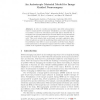Free Online Productivity Tools
i2Speak
i2Symbol
i2OCR
iTex2Img
iWeb2Print
iWeb2Shot
i2Type
iPdf2Split
iPdf2Merge
i2Bopomofo
i2Arabic
i2Style
i2Image
i2PDF
iLatex2Rtf
Sci2ools
MICCAI
2004
Springer
2004
Springer
An Anisotropic Material Model for Image Guided Neurosurgery
In order to combine preoperative data with intraoperative scans for image-guided neurosurgery visualization, accurate registration is necessary. It has been determined previously that a suitable way to model the non-rigid deformations due to brain shift is via a biomechanical model that treats the brain as a homogeneous, isotropic, linear elastic solid. This work extends that model-based non-rigid registration algorithm to take into account the underlying white matter structure, derived from diffusion tensor MRI, to more accurately model the brain. Experiments performed on retrospective surgical cases were used to evaluate the results of the registration algorithm in comparison to the earlier model.
Image-guided Neurosurgery Visualization | Medical Imaging | MICCAI 2004 | Non-rigid Deformations | Non-rigid Registration Algorithm |
| Added | 02 Jul 2010 |
| Updated | 02 Jul 2010 |
| Type | Conference |
| Year | 2004 |
| Where | MICCAI |
| Authors | Corey Kemper, Ion-Florin Talos, Alexandra Golby, Peter M. Black, Ron Kikinis, W. Eric L. Grimson, Simon K. Warfield |
Comments (0)

